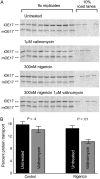The chloroplast Tat pathway utilizes the transmembrane electric potential as an energy source
- PMID: 17513364
- PMCID: PMC1959559
- DOI: 10.1529/biophysj.106.098731
The chloroplast Tat pathway utilizes the transmembrane electric potential as an energy source
Abstract
The thylakoid membrane, located inside the chloroplast, requires proteins transported across it for plastid biogenesis and functional photosynthetic electron transport. The chloroplast Tat translocator found on thylakoids transports proteins from the plastid stroma to the thylakoid lumen. Previous studies have shown that the chloroplast Tat pathway is independent of NTP hydrolysis as an energy source and instead depends on the thylakoid transmembrane proton gradient to power protein translocation. Because of its localization on the same membrane as the proton motive force-dependent F(0)F(1) ATPase, we believed that the chloroplast Tat pathway also made use of the thylakoid electric potential for transporting substrates. By adjusting the rate of photosynthetic proton pumping and by utilizing ionophores, we show that the chloroplast Tat pathway can also utilize the transmembrane electric potential for protein transport. Our findings indicate that the chloroplast Tat pathway is likely dependent on the total protonmotive force (PMF) as an energy source. As a protonmotive-dependent device, certain predictions can be made about structural features expected to be found in the Tat translocon, specifically, the presence of a proton well, a device in the membrane that converts electrical potential into chemical potential.
Figures




Similar articles
-
The chloroplast Tat pathway transports substrates in the dark.J Biol Chem. 2008 Apr 4;283(14):8822-8. doi: 10.1074/jbc.M708948200. Epub 2008 Jan 9. J Biol Chem. 2008. PMID: 18187420
-
The thylakoid delta pH/delta psi are not required for the initial stages of Tat-dependent protein transport in tobacco protoplasts.J Biol Chem. 2005 Dec 16;280(50):41165-70. doi: 10.1074/jbc.M509215200. Epub 2005 Oct 7. J Biol Chem. 2005. PMID: 16215228
-
Chloroplast biogenesis. Regulation of lipid transport to the thylakoid in chloroplasts isolated from expanding and fully expanded leaves of pea.Plant Physiol. 2001 Sep;127(1):184-93. doi: 10.1104/pp.127.1.184. Plant Physiol. 2001. PMID: 11553746 Free PMC article.
-
Targeting of lumenal proteins across the thylakoid membrane.J Exp Bot. 2012 Feb;63(4):1689-98. doi: 10.1093/jxb/err444. Epub 2012 Jan 24. J Exp Bot. 2012. PMID: 22275386 Review.
-
Routing of thylakoid lumen proteins by the chloroplast twin arginine transport pathway.Photosynth Res. 2018 Dec;138(3):289-301. doi: 10.1007/s11120-018-0567-z. Epub 2018 Aug 12. Photosynth Res. 2018. PMID: 30101370 Review.
Cited by
-
Intra-plastid protein trafficking: how plant cells adapted prokaryotic mechanisms to the eukaryotic condition.Biochim Biophys Acta. 2013 Feb;1833(2):341-51. doi: 10.1016/j.bbamcr.2012.06.028. Epub 2012 Jun 28. Biochim Biophys Acta. 2013. PMID: 22750312 Free PMC article. Review.
-
Oligomerization state of the functional bacterial twin-arginine translocation (Tat) receptor complex.Commun Biol. 2022 Sep 19;5(1):988. doi: 10.1038/s42003-022-03952-2. Commun Biol. 2022. PMID: 36123532 Free PMC article.
-
Effects of far-red light on fluorescence induction in infiltrated pea leaves under diminished ΔpH and Δφ components of the proton motive force.J Bioenerg Biomembr. 2013 Feb;45(1-2):37-45. doi: 10.1007/s10863-012-9476-6. Epub 2012 Oct 4. J Bioenerg Biomembr. 2013. PMID: 23054078
-
The Tat protein transport system: intriguing questions and conundrums.FEMS Microbiol Lett. 2018 Jun 1;365(12):fny123. doi: 10.1093/femsle/fny123. FEMS Microbiol Lett. 2018. PMID: 29897510 Free PMC article. Review.
-
Energetic cost of protein import across the envelope membranes of chloroplasts.Proc Natl Acad Sci U S A. 2013 Jan 15;110(3):930-5. doi: 10.1073/pnas.1115886110. Epub 2012 Dec 31. Proc Natl Acad Sci U S A. 2013. PMID: 23277572 Free PMC article.
References
-
- Berks, B. C. 1996. A common export pathway for proteins binding complex redox cofactors? Mol. Microbiol. 22:393–404. - PubMed
-
- Cline, K., W. F. Ettinger, and S. M. Theg. 1992. Protein-specific energy requirements for protein transport across or into thylakoid membranes. Two lumenal proteins are transported in the absence of ATP. J. Biol. Chem. 267:2688–2696. - PubMed
-
- Mould, R., and C. Robinson. 1991. A proton gradient is required for the transport of two lumenal oxygen-evolving proteins across the thylakoid membrane. J. Biol. Chem. 266:12189–12193. - PubMed
Publication types
MeSH terms
Substances
LinkOut - more resources
Full Text Sources
Research Materials

